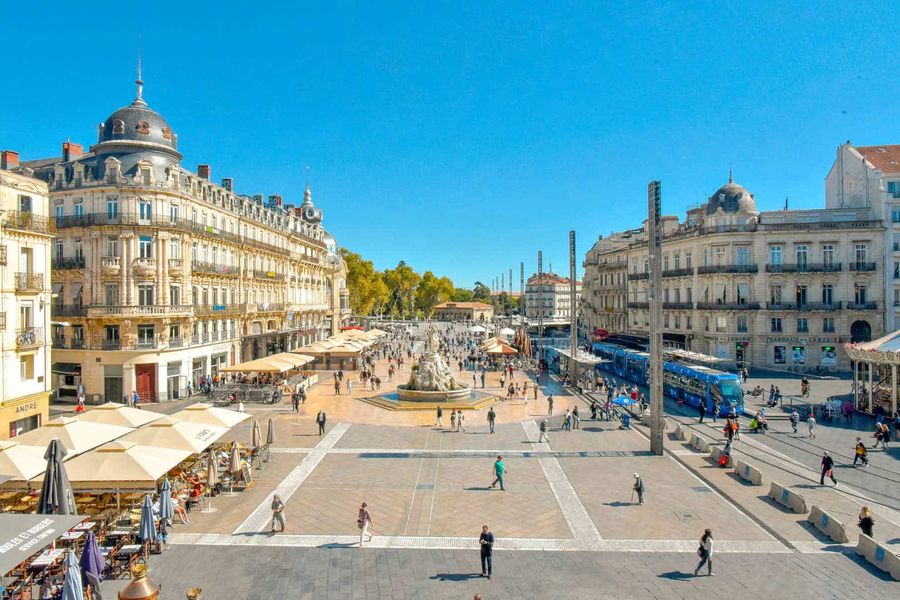
Montpellier
Located in the sunny region of Occitanie, just a few miles from the Mediterranean coast, Montpellier is one of southern France's most charming and vibrant cities. With a rich history dating back to the Middle Ages and a reputation as a center for education, art, and culture, Montpellier is a destination that perfectly blends the old with the new. Whether you’re strolling through its medieval streets, soaking up the sun in its many parks, or discovering its modern architectural marvels, Montpellier is a city that enchants visitors with its energy and beauty.
A City with Deep Historical Roots
Montpellier’s history stretches back to the 10th century, when it was founded as a trading post by the Counts of Toulouse. Unlike many other major cities in southern France, Montpellier was never a Roman settlement. Instead, it grew quickly as a center of commerce, attracting merchants from across the Mediterranean. Its strategic location near the sea, along important trade routes, made it a thriving medieval hub.
In the 12th century, Montpellier established itself as a center for learning with the founding of its School of Medicine, one of the oldest in the world still in operation today. The city's intellectual reputation was further solidified with the creation of the University of Montpellier in the 13th century, drawing scholars and students from all over Europe. Montpellier’s cultural and economic prosperity continued into the Renaissance, and its historical legacy can be seen today in its grand buildings, charming squares, and medieval streets.
Top 5 Unique Characteristics of Montpellier
1. Place de la Comédie
At the heart of Montpellier lies the Place de la Comédie, one of the largest pedestrian squares in Europe. The bustling square is surrounded by beautiful Haussmannian buildings, cafes, and the famous Opéra Comédie, making it the perfect place to people-watch and soak in the city's lively atmosphere. At the center of the square stands the Three Graces Fountain, a symbol of Montpellier's elegance. Day or night, Place de la Comédie is the beating heart of the city, where locals and visitors gather to enjoy the vibrant ambiance.
2. The Faculty of Medicine and the Botanical Garden
Montpellier is home to one of the world’s oldest and most prestigious medical schools, founded in 1220. The Faculty of Medicine has seen many notable scholars pass through its halls, including Nostradamus and François Rabelais. Nearby, you’ll find the Jardin des Plantes, the oldest botanical garden in France, founded in 1593 by King Henri IV. It served as a training ground for medical students learning about medicinal plants and remains a beautiful, tranquil space for visitors to explore rare plants and flowers.
3. Promenade du Peyrou
The Promenade du Peyrou is a majestic, elevated park that offers stunning views over Montpellier and the surrounding countryside. It’s home to the impressive Peyrou Water Tower, built in the 18th century to supply the city with water from the Saint-Clément Aqueduct, which can still be seen stretching across the landscape. The park also features a grand statue of Louis XIV on horseback, emphasizing Montpellier’s historical connection to the French monarchy. It’s the perfect spot for a leisurely stroll or a picnic with views of the distant Pic Saint-Loup.
4. Antigone District
While Montpellier is steeped in history, it is also a city that embraces modernity. The Antigone District, designed by Spanish architect Ricardo Bofill in the late 20th century, is a striking example of the city's forward-thinking approach to urban planning. This expansive, neoclassical-inspired district contrasts with the city’s older neighborhoods, featuring wide, open spaces, fountains, and grand buildings. The Place du Millénaire and Esplanade de l'Europe are highlights of this contemporary area, showcasing the city’s blend of tradition and innovation.
5. Musée Fabre
Art lovers should not miss the Musée Fabre, one of the most important art museums in France. Established in 1828, it houses an impressive collection of works from the Renaissance to contemporary art, including masterpieces by artists such as Delacroix, Courbet, and Pierre Soulages. The museum’s modern extension offers stunning views of the city and showcases temporary exhibitions, making it a must-visit for those looking to immerse themselves in Montpellier’s rich artistic heritage.
Montpellier Today: A Modern Hub of Innovation and Culture
Today, Montpellier is a city that thrives on innovation while celebrating its rich history. It is one of the fastest-growing cities in France, known for its cutting-edge research institutions, particularly in the fields of medicine and technology. With a large student population, thanks to the prestigious University of Montpellier, the city exudes a youthful and energetic vibe.
Montpellier’s Mediterranean climate, with over 300 days of sunshine per year, adds to its appeal, making it an ideal destination for both locals and tourists to enjoy the outdoors. The city is also a gateway to the nearby Camargue region, Mediterranean beaches, and picturesque Languedoc vineyards.
Fun Facts About Montpellier
Montpellier is home to France’s oldest medical school, and it’s still in operation today.
The Three Graces Fountain in Place de la Comédie is a famous symbol of the city, representing the Greek goddesses of charm, beauty, and creativity.
Nostradamus, the famous seer, studied medicine at the University of Montpellier.
Montpellier has no Roman origins, which is unusual for cities in southern France; instead, it grew as a commercial hub during the Middle Ages.
The city is often called “La Surdouée”, meaning “the gifted one,” because of its reputation for excellence in education and innovation.
From its medieval history and world-renowned medical school to its modern districts and vibrant arts scene, Montpellier is a city that offers something for everyone. Whether you’re exploring its ancient streets, relaxing in its parks, or enjoying its cultural events, Montpellier is a destination that captures the essence of southern French charm and innovation.